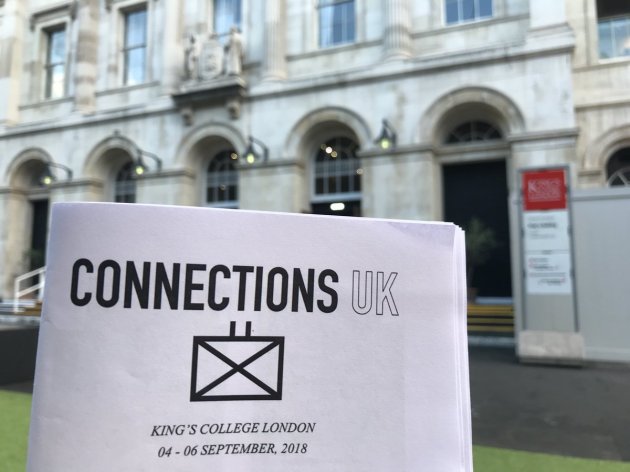
Photo credit: Anthony Sharman (@Ant_Sharman)
The Connections UK 2018 professional wargaming conference concluded yesterday, and a very excellent conference it was. The event was hosted by the Department of War Studies at King’s College London, and cosponsored by the Defence Academy of the UK and the Defence Science and Technology Laboratory. Around two hundred people were in attendance this year, making it the second largest conference of its kind ever (with Connections US having taken first spot earlier this year).
Tuesday, 4 September
As is tradition with Connections UK, the first day gave participants the option of either attending a day-long introduction to wargaming for beginners course (ably taught by Tom Mouat and Jerry Elsmore), or taking part in a megagame designed by Jim Wallman. The former included hands-on experience with Battlegroup Krieggspiel, a commercial off-the-shelf (COTS) game, and a matrix game. The megagame was A Green and Pleasant Land, examining British national resilience in the face of mounting crisis and a hostile adversary employing the tools of hybrid warfare.
Together with about a hundred others, I opted for the megagame, facilitating the game as Control for the Red Cell—a team of nefarious simulated Russians trying to destabilize the UK against the backdrop of a crisis in the Baltics and NATO mobilization. Led by the nefarious Phil Pournelle (doing his best Vladimir Putin imitation), the Read Team used social media to aggravate political tensions, secretly funded alt-right demonstrations, and engaged in sporadic arson attacks—hoping to overwhelm the overstretched British police. There was also quite a lot of hacking, including an extraction of interesting financial information from the Trump Organization, and sabotage of the Automatic Identification System (AIS) used for maritime navigation.

The British Prime Minister speaks to the cabinet and other officials. Photo credit: Jim Wallman/Stone Paper Scissors.
The vast majority of players assumed the roles of various British government departments and officials, trying to deal with a plethora of incidents. Most incidents were simply random events that had nothing to do with Russia, but even those that were connected were rarely linked back to Moscow.

Russian plotting underway.
There were, however, some exceptions. A GRU agent who had been hiring neo-Nazi thugs to torch British mosques was arrested by the Metropolitan Police. Even more serious, a Spetsnaz mission to sabotage Royal Navy vessels in Portsmouth was detected and blocked—ultimately resulting in the arrest of the Russian special forces. This occurred amid growing military tensions in Europe. When the British cabinet twice relocated to a secure bunker outside London—once as a continuity-of-govermnment drill, the second time in response to the discovery of Russian listening devices at Number 10 and the cabinet offices—Russia grew fearful that this might be early warning of an impending NATO first strike.
A last-minute telephone call between the Russian President and British Prime Minister (which hilariously took 10 minutes to arrange because of poor cell reception, even though the principals were in adjacent rooms) deescalated things. British mobilization went well, and the North Atlantic Council seemed near-unanimous on supporting an Article Five response in support of their Baltic allies—although the British PM seems to have offered to pull back forces, which was seen by the Russians as a major accomplishment. Bob Cordery offers his own perspective on his blog Wargaming Miscellany:
As tensions rose, so did the level of problems that we had to find solutions to. The discovery of listening devices in the Cabinet Room and the arrest of a four-man team of Speznatz in Portsmouth precipitated matters, and we – the Cabinet – moved to the secure bunker, along with representatives (usually the PUS) of the ministerial teams. I think that I shocked my Cabinet colleagues when I ordered that all means – however extreme they might be – should be used to extract information from the captured Russian Special Forces Team. I asked that it be done by contractors and that it should take place outside the UK. I then told the Cabinet that this was a decision that I alone would make, and that they bore no responsibility for it.
As events moved close and closer to the possibility of open conflict with the Russians, I received a message that the President of the Russian Federation wished to speak to me on the telephone. There then proceeded to be what can only be described as a farcical situation. Although he was physically in an adjoining room, the phone link just would not work properly. At one point I said ‘Hello, Vladimir’ … and was greeted by a recorded announcement that the person I wanted to talk to was not available and that I could leave a message after the tone! (One hopes that in real-life, this could not happen!)
Once we did manage to talk, we were able to de-escalate the situation, with both sides agreeing to pull back … although I suspect that we withdrew more than they did! At this point the game ended, and we moved to the de-brief.
A Green and Distant Land was not intended to be a hyper-realistic simulation of British emergency preparedness. Rather, it was intended as a conference ice-breaker, an opportunity to network, and a demonstrator for various gaming techniques. This it did very well, and there were several game elements that I am likely to steal borrow from Jim in my own future game designs.
Wednesday, 5 September
Day 2 of Connections UK—and the first day of conference panels and presentations—started off with a formal welcome from Wyn Bowen, Head of the School of Security Studies at King’s College London. Conference coorganizer Graham Longley-Brown (LBS) then outlined the conference programme..

Graham Longley-Brown discusses the wargaming process and the structure of the conference.
Graham noted that this had been designed around the cycle of wargaming, as identified in the UK Defence Wargaming Handbook:
- Initiation
- Design (to a purpose)
- Development (and playtesting)
- Execution (and facilitation)
- Validation
- Refinement
He noted a number of areas in which he felt that wargame project management and validation was much more advanced in the US than in the UK and elsewhere.
This was followed by a session on wargame design, introduced and chaired by Matt Caffrey (US Air Force Material Command).
Phil Sabin (King’s College London) talked about dilemmas and trade-offs in wargame design. These include:
- the dilemmas faced by designers (rigid vs open rules/adjudication, open vs hidden information, detail vs abstraction, complexity vs accessibility, manual vs digital, and luck vs skill);
- the need to capture real world-dilemmas (such as resource scarcity and prioritization, attack vs defence, concentration vs dispersion, efficiency vs surprise/unpredictability, boldness vs caution, inherent cost-benefit trade-offs, cooperation vs self-interest);
- incorporating these into a game by providing players with choices and options.
Dilemmas may be rooted in incalculability (the sheer number of possible approaches), uncertainty (for example, hidden information), and incommensurability. Wargames also have the potential to reveal previously unidentified dilemmas and elicit creative approaches.
Game designer Brian Train spoke on game design as a form of journalism, focusing on “news games.” He noted that while the scholarly literature on such games has largely focused on digital games, there is a rich tradition of manual games that have editorial/advocacy/social awareness or documentary/educational/informative content. His earliest example was a 1791 roll-and-move game of the French Revolution. Another example was Occupation, a game that was secretly produced during WWII on German-occupied Jersey. Today, TerrorBull Gamesis well-known for its satirical and educational games. Brian also discussed the Strategy & Tactics model of games coupled with accompanying magazine analysis. Finally, Brian addressed the rapid development of games to explore contemporary or ongoing conflicts.
Anna Nettleship addressed challenges in wargame design. In historical games, she noted, one must abstract real events in-game mechanics, and to do so in a way that remains appropriately playable for the players. The game design, rules, and supporting material must communicate effectively with the player. The game system should incentivize appropriate play. She stressed the importance of intensive playtesting in identifying weaknesses and fixing them. Regarding future conflict simulations, she noted the importance of linking the game design to design objectives. Players need to think how they can best get players to act within their game roles.
During subsequent discussion, several audience members raised the challenges of wargaming future conflict, including hybrid warfare. Phil highlighted the need to couple the lessons of the past with an appreciation of the possible effects of technological change as well as leaving scope for innovative play by players. Brian stressed the importance of exploring how different actors might exploit various mechanisms of hybrid warfare, even if the game is necessarily speculative. Anna and Phil also noted that wargames can be useful in telling us what might happen, even if there can be no certainty the games are indeed predictive.
The next series of presentations, chaired by Graham Longley-Brown, examined wargame development.
Col Richard Taylor (British Army) and Nigel Paling (UK MoD) spoke on analysis in experimentation wargaming, looking at the EX SPECTACULAR STRIKE wargames. These examined how the new British STRIKE brigade might operate in contemporary European high-intensity operations. They emphasized that capabilities cannot be characterized solely in terms of modelling and simulation of equipment, since much depends on the development of innovative tactics and approaches. A bespoke wargame is thus needed, rather than simply using existing collective training systems, and an integrated analysis and experimentation “campaign” is required. The Rapid Campaign Analysis Toolset (RCAT) was used to explore the relevant questions, using a standard defence scenario. The STRIKE! Manual game was developed by Dstl and employed to explore higher resolution assessment of tactics and alternative approaches. The games highlighted the asymmetric value of unpredictability, that speed of assembly allows you to fight faster, that multi-domain integration is key, dispersion and “swarming” can enhance tempo, and that self-reliance enhances reach and flexibility, but is dependent on austerity, mobility, and accuracy. They noted that accurate assumptions are critical for credible outputs, wargaming offers insight into the human element, and that a “safe to fail” environment is useful—since one often learns the most from “losing.”
Nick Reynolds spoke about developing the KCL crisis simulation, an annual weekend crisis game run by KCL students. Many participants had significant prior professional experience in defence and related areas. The simulation has tried to move beyond a model UN negotiation model, and enhance the wargaming and other simulated operational elements. Free kriegsspiel adjudication was used. His comments on the dangers of “breaking immersion” during the game. He felt that free kriegsspiel in inappropriate for complex operations (although I’m not sure I entirely agree—adjudication in Brynania is largely free kriegsspiel, and I would argue that it especially well-suited for complex POL-MIL games). Key to his presentation was the importance of managing the flow of information and game decisions in a large, complex game. He also noted the importance of signally public relations, political, legal, and similar non-tangible considerations and constraints, in order the prevent the game from devolving into an unrealistic hard power “hyper-realism”
Dave Manley (UK MoD) reviewed the High Northseries of nested games. The project grew out of Connections UK 2017 conference, and the interest in future arctic issues by the Development, Concepts and Doctrine Centre. A matrix game was used to explore strategic and political issues, RCAT was used to explore operational issues, and the ASUW game was used to explore tactical issues. He helpfully identified a series of risks, difficulties, and mitigations. One was the necessity of keeping players on (analytical) target, which was mitigated by the game controller nudging and “critical thinker” SME comments. Another was unexpected flow-down factors, where a higher-level game would introduce issues and challenges that needed to then be incorporated into a lower-level game. Free kriegsspiel seemed most appropriate for the higher level game, becoming more rigid in the more operational and tactical games. One observation that came out of the games was the unlikelihood of open military confrontation in the High Arctic.
Highly regarded wargame designer (and former CIA instructor) Volko Ruhnke spoke about model calibration. He started with the challenge of building harpsichords at home to highlight how to develop a finely tuned instrument, noting that tuning is a different skill than both design and play. He differentiated between calibration (model outputs are useful for intended purpose) and accuracy(the model reflects real-world dynamics)—essentially, processes of validation and verification. He ran a quick live-action game that was, in essence, a pandemic model.
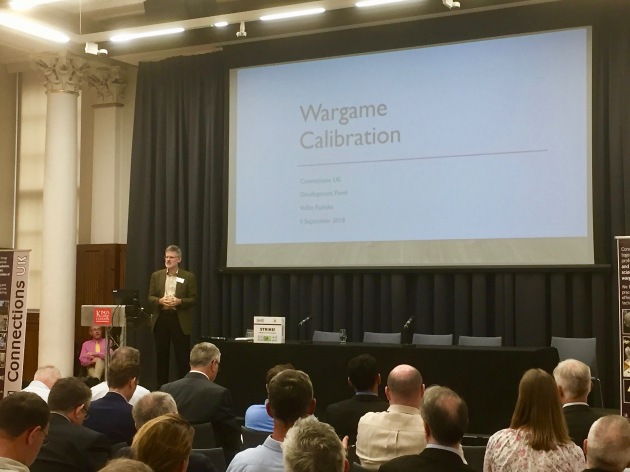
Volko Ruhnke discusses wargame calibration.
He then used this to highlight how, by changing the rules and rates and tweaking the model, rather different outcomes would result. There is value in “bracketing the target” by making adjustments that both overrepresent and underrepresent the desired effect, thereby enabling one to narrow down the required changes. In response to questions, he noted that calibration occurs throughout the design and playtest process.
The broader panel discussion addressed how to engage involuntary players who did not choose to, and may not want to, play—for example, military personnel assigned to a wargame. Questions were raised about how to recruit appropriate players, especially for the Red cell in an analytical game. Panelists highlighted the value of innovative and diverse opponents. In concluding comments, Graham underscored the importance of scenario development, and warned against pre-scripted scenarios that heavily constrain player choice
Lunch followed, and the first session of the Connections Game Fair, with twenty or so games on display,. These ranged from a Dstl hybrid warfare matrix game and their STRIKE! battlegroup board game, to a Swedish National Defence University operational-level game, through to Brian Train’s Second Lebanon War and a game on Future Artillery Concepts. A second session followed in the evening.
Juliette Le Ménahèze, Harrison Brewer, and I ran two games of We Are Coming, Nineveh, our wargame-in-development of Iraqi operations against Daesh in West Mosul (2017). I’ll post a full update on the playtesting to PAXsims in the near future.

Demonstrating Playing We Are Coming, Nineveh.. Photo credit: Harrison Brewer.
Unfortunately, because I was busy overseeing bitter street-fighting in West Mosul, I did not get much of a chance to look at the others.

Mike Young demonstrates the STRIKE! wargame from Dstl. Photo credit: Tom Mouat.

James Halstead and Fog on the Somme. Photo credit: Tom Mouat.

Brian Train demonstrates Second Lebanon War. Photo credit: Tom Mouat.

Tom Mouat’s Section Commander. Photo credit: Tom Mouat.
This slideshow requires JavaScript.
The WATU wargame was also on display (photo credits: Katie Bramwell).
The other activity of Day 2 was a keynote address by Volko Ruhnke and Brian Train.
Volko spoke about wargames and systems thinking, reprising many of his comments from Connections US in July. He identified various sources of analytical surprise—deliberate hostile action, tectonic shifts, and system shifts in which the dynamics of complex systems interact to produce major change. From this he went on to explore the challenge of modelling complex systems, noting both that such models are inevitably simplified and full or errors—yet also essential to make some sense of the world. He emphasized the importance of harvesting the wisdom of crowds and incorporating diversity. Wargames capture a particular model, often in a way that is accessible to players. Rigid games have very explicit model specification but may be too bound. Open games incorporate opportunities for innovation, but the model is often much less clear. Matrix games are a hybrid approach, which incorporate flexibility and leverage the expertise of participants. Computation and agent-based modelling can offer considerable insight into outcomes of complex systems, but the underlying model may not be accessible (and the user interface may be very important to allow the user to know what is going on). Volko also offered advice on game development, much of which hinged on the importance of repeated playtesting and encouraging feedback and critique.
A stimulating on-stage conversation between Volko and Brian followed, examining the question of creativity. Martin Mull once said that “writing about music is like dancing about architecture,” making the point that you also need to listen to and experience music. Brian amended this to remark that “Game design is like dancing through architecture,” allowing one to experience the flow and form—although one also needs to game too. Brian’s usual design process isn’t always linear, but it is iterative. He has to have some initial interest. There then follows a period of incubation, which is followed in turn by moments of insight and inspiration during which the game subsystems develop. There are usually lots of ideas, and over time the bad ones get thrown out and the good ones are refined. Novelty is something which always attracts him to game topics and designs. At the same time, designs often borrow and adapt mechanisms pioneered by others in other games. Brian admitted to a certain degree of imposter syndrome at times, feeling that his work is less elegant or otherwise not as good as games designed by others (a remarkable admission from one of the world’s leading and most innovative wargame designers). The question and answer period followed, much of which focused on their favourite game systems and mechanics. It was a terrific session and format.
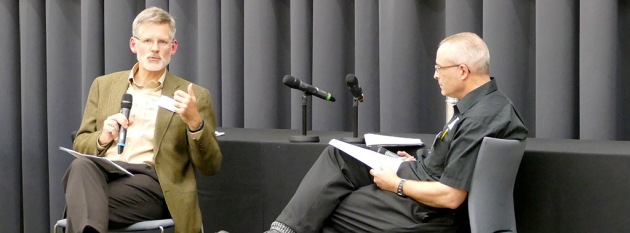
Volko Ruhnke and Brian Train. Picture credit: Tom Mouat.
Thursday, 6 September
The final day began with a panel on wargame execution, chaired by Howard Body (UK MoD).
Aggie Hirst (KCL) spoke about play as pedagogy, examining the use of wargames for educational and training purposes in the US DoD military. She emphasized three main themes: play as a pedagogical tool, the role of immersion and player agency, and the value of critical thinking and “dialectical play.” She raised the question of whether immersion can interfere with learning, to the extent that reflexivity is undermined and players become objects, rather than subjects, of the game. It is important to use games to teach how to think, not what to think. This may involve punctuating immersion, thereby ensuring that players are engaged in a dialectic with the game. Her research will ultimately be published as a book (to which I am certainly looking forward).
Next, Erik Elgersma (FrieslandCampina) spoke on wargaming as a hidden driver behind cheese market victories, highlighting the value of business wargamimg, whereby potential commercial courses of action are stress-tested. This approach serves as a team-building process that ultimately enhances capabilities. Participants start by playing Red, outlining the objectives and strategy of a commercial competitor. Having done this, they develop and then test their own plans from a Blue perspective. He stressed the importance of recruiting a strong project leader, choosing a suitable topic/scenario, ensuring commitment and support from principals, and ensuring the wargame has a clear focus. Good timing is important—wargames can be premature or stale, with limited shelf-life. A good team of participants is important, as is a good organizational culture in the room that encourages everyone to voice ideas. Good preparations (such as suitable pre-reads) pay off. Analysis and reporting must be clear, and not ambiguous. The findings need to be effectively integrated into business strategy. Finally, he stressed communications, communications, communications.
Erik also mentioned how things can go off the rails, through poor representation of reality, hidden (political or organizational) agendas, or a mismatch between the game and the authority of participants. In the later question period, he noted that cheese marketeers are as vulnerable to mirror-image biases as any other analysts or game participants.
Karl Selke (Group W) presented on empowering defense wargaming through automation, focusing on the Standard Wargame Integration Facilitation Toolkit (SWIFT) produced for the US Department of Defense. The software captures all aspects of the game. A user builds their game space (map/board), including layers and overlays, and builds their units and assets. The game can be adjudicated externally or can be automated. He discussed some of the expectations and challenges when developing and promoting technological supports and solutions.\
Appropriately enough, digital wargame and wargame support tools were on display during the coffee and lunch breaks. These included SWIFT, as well as a Dstl demonstration on adapting augmented and virtual reality tools; NSC and iNet; Conductrr and TeamXp; and several games from Slitherine and Matrix Games.

Using SWIFT to display, document, and facilitate a wargame.
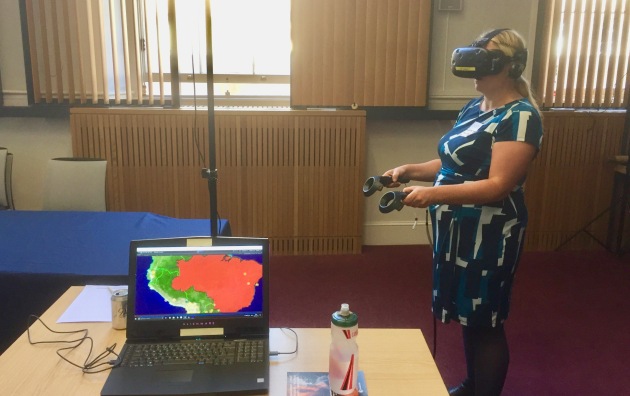
VR tools in wargaming.

Conductrr on display.
The next panel, chaired by Brian Train, explored wargame validation.
LtCol Neil Stevens (British Army) and LtCol Ranald Shepherd (British Army) discussed selecting, playing, and assessing a commercial off-the-shelf wargame (in this case, A Distant Plain). They discussed how to convince the players that a COTS wargame was worth their time. After playing, participants reported that A Distant Plain had given them better appreciation of the broader context of counter-insurgency in Afghanistan (4.2/5.0 in a post-game survey), although it was somewhat less effective in offering insight into COIN warfare (3.78). Positive effects were noted in terms of practicing risk-taking, decision-making, and collaboration. Overall the exercise scored high (4.67) as an overall experience, both in terms of learning and enjoyment.
John Curry (History of Wargaming Project) talked about wargaming and reality: a case study of the Ukrainian crisis, 2014-present. He questioned whether wargames had always had the positive effects reported. The interwar US Naval War College wargames, for example, were rather different from the way naval engagements were actually fought during WWII. He also quickly reviewed several wargames on modern warfare used for training during the Cold War era. There was not only significant variation in their assumptions, but also were wrong in some respects, or missed key issues (such as Soviet supply constraints).
He used such observations as a preamble to examination the Ukrainian war. Fighting has highlighted the value of UAVs and indirect fire. MANPADS proved effective against rotary assets. Tanks remained powerful on the battlefield. Matrix games, he suggested, had limits in anticipating black swans and future developments such as encountered in the Ukraine. Some pre-crisis board games (such as Millennium Wars: Ukraine) placed too much emphasis on large formations, or otherwise failed to predict important developments. Digital games often made inappropriate assumptions too. John stressed that wargaming does have value, but that appropriate caution needed to be exercised in using them to anticipate future military challenges. In response to questions, he called for more research on what games proved prescient, and why. In a follow-up question I asked how we avoid demonstrating the value or weakness of wargaming by cherry-picking vignettes. He (quite rightly) responded by stressing the need to more systematically survey wargame outputs.
Another comment noted that the benefit of wargames is also the cognitive development it encourages, quite apart from tactical/operational/strategic insights. It was also noted by panelists that wargames may contribute to networking and agility that proves of value when the unexpected is encountered. Also, the problem in some cases may be one of how game lessons are interpreted, (mis)applied, or missed, rather than the game itself.
Phil Pournelle (LTSG) looked at refinement of wargames throughout the wargaming lifecycle. He emphasized that game methodology needs to be matched to the questions being asked, and what the designer or sponsor thinks about a game is not always what the audience (or the sponsors’ boss) thinks. Games need to be supported by a joint planning process prior to the game, and teams will have to adjust plans as they interact with adversaries. Insights from the game should then inform refinement of the next game. He also discussed capturing lessons, through rapporteurs, surveys, hotwash, and structured analytical techniques—and the strengths and weaknesses of each. He noted the particular value of critical event analysis to understand game trajectories and their drivers. These critical events may generate questions for future examination.
Phil also discussed the Defense Wargame Alignment Group (DWAG) in the US Department of Defense, including the role of the Wargame Incentive Fund and Wargame Repository. In subsequent discussion, Phil stressed the importance of playing games widely to develop wargame design skills, and to acquaint oneself with the various techniques, methods, and game mechanics that are available.

Phil Pournelle highlights the strengths and weaknesses of different wargaming approaches.
LtGen Sir David Capewell offered a (retired) senior officer’s perspective in a presentation on wargaming to win in a volatile future. He stressed the value of wargaming as a method for fostering critical thinking skills. He argued that we are in the midst of a new and emerging geostrategic environment, characterized by the emergence of new issues and dynamics. He underscored the changing information environment, the challenged posed by (volatile) adversaries, and the “hybrid conundrum” whereby it is difficult to know how to respond to irregular challenges. He suggested that it was difficult to find Red Team players that could effectively represent this.
There was much here I agreed with, and it was good to have such a senior (former) officer speaking to the group to offer a wargame-user’s perspective. However, it is also important to move beyond catch-phrases. Some aspects of change, it seemed to me, were overemphasized: geopolitics has always been complex and dynamic, especially outside the Cold War paradigm. Much of what is termed hybrid warfare is composed of tools and approaches that have been in use for decades, even centuries. I am not suggesting that there is nothing new—there absolutely is. However, what is key is to determine what has changed (irregular actors using UAVs) and what has not (massed artillery fires kill infantry), in a context of both continuity and innovation.
For me, the most important contribution of the presentation was to underscore the need for wargame designers to wrap their games in appropriate jargon if they are to attract the attention of some senior decision-makers.
In the subsequent question and answer, Sir Capewell was asked if he had ever changed his mind as the result of a wargame. He said he had. In the case of Afghanistan, wargames suggested that troops could be disengaged quickly and quietly at night, rather than having to first reinforce forward. He also pointed to the 2014 West Africa Ebola crisis, where wargaming highlighted the importance of cultural practice (notably body-washing and handling) in limiting the spread of disease. I found this a somewhat interesting response, given that this was understood by many public health professionals well before the epidemic, the issue being noted (for example) in humanitarian guidance sponsored by the UK Department for International Development in 2002. This suggests that planning wargames for senior staff may actually serve an educational function too, flagging issues that they might otherwise fail to appreciate from briefing or other materials.
After lunch, a panel chaired by Colin Marston (Dstl) discussed various issues of wargame analysis. I was one of the panelists, so my notes here are a little more hurried.
LtCol Rob Burks (US Army) spoke on US/DoD best and worst practices. He warned of the challenges posed by wargame teams without the necessary skills, unclear objectives and questions, and weak data collection and management plans. He stressed the importance of dialogue with the sponsor to clarify objectives and key questions, noting that while you can’t always get what you want, if you try sometime you find you get what you need. He stressed the importance of playtesting—and not only playtesting the game design, but the data collection and analysis plan too. Knowing who the players are is important, before the game design is finished. He also noted that games are at risk of being sidetracked, and that contingency plans and parking lots can be useful tools in game facilitation (“let’s park that issue now and get back to it later” so that you can focus on main issue).
Peter Williams (DST) addressed designing analytical games with a view to successful data capture, management, and analysis. He outlined a holistic wargame design process, whereby understanding the client problem leads on to designing an appropriate wargame, collecting good data, undertaking good analysis to produce good answers. He emphasized the value of break-point analysis, which seeks to determine where and when the capability of force X is likely to work, and why—and the point at which it is no longer effective. A wargame needs to enable smart people to be smart (and innovative and devious), and the tools need to be present in the game to allow them to do this.

Peter Williams discusses the holistic wargame process/
I delivered my report on the DIRE STRAITS experiment from Connections 2017, addressing cognitive bias in wargame analysis (slides here). This was similar to the presentation I made in July at the Connections US conference. Our findings suggested that different analytical teams assigned to report on the same wargame might reach very different conclusions. Various types of cognitive bias (such as confirmation bias) might be responsible for this. The implication was that greater attention needed to be paid to how game analysis was developed and aggregated, including the possible use of a Red Team analytical cell to provide a possibly alternative perspective on the findings.
The next session of the conference was an informal panel discussion on wargame facilitation, featuring Tom Mouat, Jim Wallman, and Paul Strong (Dstl), and myself. Various questions had been gathered from conference participants over the past two days, and Graham-Longley Brown acted as questioner. Some important issues were raised, including dealing with difficult players, the dangers of assuming a too-active role, and various mistakes we had made in the past.
Finally, it fell to Phil Sabin (KCL) to make some concluding comments on the conference. The main thrust of his remarks was the need to increase the diversity of the wargaming community, in terms of gender, ethnic and national background, age, and experience. Connections UK did very well in attracting an international audience, with participants from 19 different countries. Judging from the sixty or so people who opted for the introduction to wargaming course, the conference also did well at bringing newcomers into the community. Half or more of those in attendance were not hobby wargamers, highlighting how effective Connections UK has been in expanding the community beyond the usual gaming geeks.
Regarding gender, however, there remains considerable room for improvement. By my rough estimate, around 10-15% of participants (and fewer than 5% of presenters and panel chairs) were women—a somewhat lower proportion than at American version. This is, of course, an issue we have discussed before at PAXsims, and to the organizers’ credit the issue was raised and recognized repeatedly. Half of the PAXsims contingent (comprising myself and Tom Mouat, plus research associates Harrison Brewer, Kia Kouyoumjian, and Juliette Le Ménahèze, and volunteer Keiko Ivinson) were women, so I would like to think we made our own modest contribution in that direction.
Overall, it was a very productive and stimulating three days. Having attended Connections US in July, it is interesting to reflect on the subtle differences between the two events. The focus and composition of the latter can vary a little depending on where it is held, but in general there are significantly more serving military folks with wargaming somewhere in their job descriptions or on their to-do lists. Connections UK seems to attract more with POL-MIL interests, as well as gamers who have some position or interaction with government but aren’t necessarily doing much official gaming. Given that US defence expenditures are around 13 times higher than those of Britain, that is to be expected. There is also a certain eccentricity to many British (hobby) wargamers that affects the official side too—I’m not sure that the UK megagame opener would necessarily translate well to a US professional setting. The US conference often delves deeper into issues of methodology (in part because of the efforts of people like Yuna Wong and Stephen Downes-Martin to deepen the intellectual and research foundations of wargaming). However, many UK (and European) wargamers are operating in more austere resource environments, and in some cases things that work in well-funded US wargames may be less feasible elsewhere in NATO and beyond.
UPDATE: the conference presentations are all now available at the Connections UK website.

 Designing a purely political game has a number of issues that affect the megagame design. In this case the main design aim was a game that would be accessible to non-gamers, or at least people for whom the only board game they would have heard of would be Monopoly. In addition the game should maximise negotiation to give the players the chance to not only negotiate but to experience, directly in the game, second (and even third) order consequences of their negotiations. Something that the players might rarely get to do in a safe-to-fail environment.
Designing a purely political game has a number of issues that affect the megagame design. In this case the main design aim was a game that would be accessible to non-gamers, or at least people for whom the only board game they would have heard of would be Monopoly. In addition the game should maximise negotiation to give the players the chance to not only negotiate but to experience, directly in the game, second (and even third) order consequences of their negotiations. Something that the players might rarely get to do in a safe-to-fail environment.


 Will to fight may be the single most important factor in war. The U.S. military accepts this premise: War is a human contest of opposing, independent wills. The purpose of using force is to bend and break adversary will. But this fundamental concept is poorly integrated into practice. The United States and its allies incur steep costs when they fail to place will to fight at the fore, when they misinterpret will to fight because it is ill-defined, or when they ignore it entirely. This report defines will to fight and describes its importance to the outcomes of wars. It gives the U.S. and allied militaries a way to better integrate will to fight into doctrine, planning, training, education, intelligence analysis, and military adviser assessments. It provides (1) a flexible, scalable model of will to fight that can be applied to any ground combat unit and (2) an experimental simulation model.
Will to fight may be the single most important factor in war. The U.S. military accepts this premise: War is a human contest of opposing, independent wills. The purpose of using force is to bend and break adversary will. But this fundamental concept is poorly integrated into practice. The United States and its allies incur steep costs when they fail to place will to fight at the fore, when they misinterpret will to fight because it is ill-defined, or when they ignore it entirely. This report defines will to fight and describes its importance to the outcomes of wars. It gives the U.S. and allied militaries a way to better integrate will to fight into doctrine, planning, training, education, intelligence analysis, and military adviser assessments. It provides (1) a flexible, scalable model of will to fight that can be applied to any ground combat unit and (2) an experimental simulation model.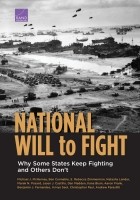 What drives some governments to persevere in war at any price while others choose to stop fighting? It is often less-tangible political and economic variables, rather than raw military power, that ultimately determine national will to fight. In this analysis, the authors explore how these variables strengthen or weaken a government’s determination to conduct sustained military operations, even when the expectation of success decreases or the need for significant political, economic, and military sacrifices increases.
What drives some governments to persevere in war at any price while others choose to stop fighting? It is often less-tangible political and economic variables, rather than raw military power, that ultimately determine national will to fight. In this analysis, the authors explore how these variables strengthen or weaken a government’s determination to conduct sustained military operations, even when the expectation of success decreases or the need for significant political, economic, and military sacrifices increases.
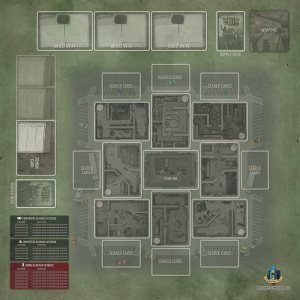





































 Registration is now open
Registration is now open















